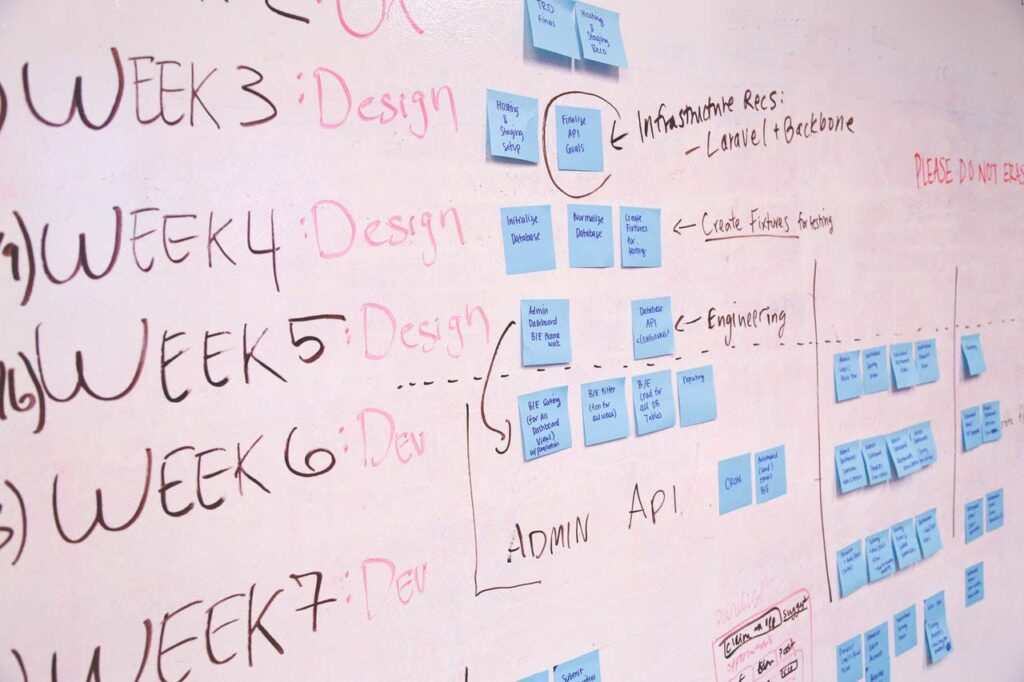Project Management IT is project management applied to Information Technology. In this quick guide, we will see what the differences and peculiarities of project management are when applied to IT, as well as some tips on how to be a better project manager on information projects.
Different Nature of IT
Before we can dive right into project management IT, let’s consider the difference that IT has compared to other disciplines.
Uncertain Results and Constraints
In IT, we often face uncertain results and we are not sure about the constraints. Unlike a construction project, which is very similar to other construction projects, each software is different and so we cannot estimate how long it will take to complete by relying on other works we did in the past.
This translates into lower visibility into the future and less precise forecasts in term of schedule and costs – that is to say, if forecasts are even possible in the first place.
Intangible Assets
When you build a house, revamp a factory, create a car or a yacht, you create something that you can touch. This is a tangible asset, something that has a value and it is expected to conserve its value over time (generally slowly declining, we call this depreciation).
In IT, it is rarely the case. Most of the deliverables we create are intangible assets, something that is abstract and conceptual. It may be the ability to perform new business functions, to do existing tasks fast, or intellectual property. No matter which type of intangible asset we are working on, since it is intangible it is hard to estimate in terms of monetary value.

This means the standard budgeting process that is applied to other functions may feel a little constrained when applied to IT. Additionally, since results often have unclear value, it is easy to embark in wasteful projects or forego projects that would bring significant benefits.
Demanding Staff
IT staff has expectations, and you need to take this into account when dealing with project management IT. Specifically, IT staff is accustomed to extensive hours at the computer and has no problem working remotely. In fact, this is what people tend to prefer, and in IT this is becoming a stronger and stronger current, especially after the COVID-19 pandemic.
This means the staff has access to many potential employers, each offering different benefits and different interesting projects. You can’t just treat your programmer like they are the assembly line of software, but instead you have to treat them with respect. Failure to do so may result in unexpected roadblocks due to poor morale and lack of motivation.
Risk of Burnout
This point connects well with the previous point. People working in IT are often stressed and at the verge of burnout. This is not always the case, it depends on the circumstances and on the project, but it is generally true.
The reason for this can be found in the uncertainty of results and constraints. Often, constraints (and especially deadlines) are enforced arbitrarily on software projects, and then they have to be followed for business reasons. To comply to this requirement, people often put long hours of work, and this can lead to burn out.
Project Management IT: The Solution
Project management IT is different from project management in construction, healthcare, manufacturing, or any other industry. For this, you need to approach your work differently as a project manager and implement true project management IT. More often than not, this translates into moving toward a more agile approach.
The Agile Approach
We already covered agile in multiple articles on ICTShore.com. Agile applies specifically to IT, and it is the approach to project management that allows for continuous changes in requirements and as much flexibility as possible.
In traditional project management, you have a fixed scope and time and cost may adjust to meet that scope. We call this the Iron Triangle, and it simply means you are crystal clear about what you want to accomplish (we call it scope), however time and cost may vary – you can increase cost to be faster or be slower to save costs. Project Management IT reverse this framework (we literally call it “reverse triangle”). In the Iron Triangle, the triangle faces upward and the scope is the top vertex. In the reverse triangle, the triangle faces downward and the scope is in the bottom vertex.

With this new approach, cost and time are fixed, and the scope varies. This sounds like “We have 8 developers for 1 month, let’s see what we can get done with that”.
Of course, this means a radical shift in perspective. In the traditional approach, since you are sure you will meet your scope eventually, there is not much concern about what is going on while you implement it. Instead, with agile, you are not sure you will meet the full scope – and the scope may even change over time. So, you should focus on value now, decomposing the larger scope into smaller parts (features) that can deliver value to the business immediately. Then, you should try to do as many features as possible with your given time and budget.
Technical Debt
We have a detailed article about technical debt if you are curious. Yet, in short, technical debt means sacrificing architectural characteristics to save time to do other features that add immediate value to the business. To do put it bluntly, it means doing scrappy work to be faster. The idea of “debt” comes to the fact that you will fix the scrappiness later, much like you repay a loan in the future.
Technical debt is an important concept you should grasp for project management IT. Much like financial debt, it is neither good nor bad, it is just debt. It depends on how you use it and why. If you never repay your technical debt (dedicate hours to improve your code), then at some point your app will become so unsustainable the team will be forced to start from scratch.
On the other hand, if you never engage in technical debt, you may be slow to introduce features that are important to the business or to the market. The IT project manager, together with the team, must evaluate when it is worth to take on more technical debt and when it is better to repay the one you already have (fixing scrappiness from the past).
In Project Management IT, take in mind that you may join a project midway, and it may already have consistent technical debt. This may constrain you, because the team has to spend significant time to reduce that debt before moving on to new features.
In short, technical debt is a powerful tool that you should consider when talking about project management IT. Remember that too much of that debt and morale will suffer, as it is never good to work on a scrappy project.
Empowering the Team
Empowering the team is a great way that Project Management IT can help deliver successful projects. In traditional environment, it may be acceptable for the project manager to just tell the team what to do in a directive way. In project management IT, this is out of question. Your team members have the highest expertise, and you should trust their judgement.
This does not mean leaving decisions unchallenged or having a laissez-faire approach. Instead, it is often implemented with daily scrum meetings, or stand-up meetings. Those meeting should last 15 minutes, and all team members should list what they are doing, what other members are doing, what they plan to accomplish for the day and if there are some roadblocks to that. Details should not be discussed in this meeting, which is to be held daily.
Instead, the purpose of the daily scrum is to surface problems, make everyone aware, and then have the appropriate people follow up on the discussion offline and fix the problem. Note that with this approach there is no top-down command, and this helps the team feel more valued and counter the risk of burnout.
Sprint Planning
Let’s get back to the agile approach for a second, which is a crucial concept in project management IT. We know that time and cost are fixed, and we can translate that into sprints. A sprint is a time (2-4 weeks in general) with known resources (known amount of developers). You are a project manager, even in IT, and you need to plan what to do in each sprint. This is called sprint planning, and means selecting the proper features to implement in the next sprint.
Most likely you will have a backlog of features, that is, a set of features that you like to implement. Engage with the team and understand the complexity of each, and even the uncertainty of developing it. If it is too uncertain, break it down into smaller features.
In this process, always consider business priorities to understand which features would deliver more value to the business. Then, agree with the team what is feasible to tackle in the next sprint. This is often done considering the complexity, which is measured in “story points”, an arbitrary number given by the team to each feature or user story. Ideally, the team has a fixed capacity of “X” story points per sprint, so you can add features to the sprint as long as the total number of story points do not exceed team capacity.
By selecting the features that deliver the most value to the business you ensure you are creating something good, and involving the team in the decision ensures good morale and a sense of ownership.
Project Management IT in Summary
In short, project management IT is just project management with some minor tweaks. This is because IT can be a special discipline, different from other more “traditional” fields, and some approaches apply better here. To recap, as a project manager in IT, you should:
- Follow an agile approach
- Manage technical debt to balance stability with speed
- Empower the team to decide how to solve problems
- Decide with the team what to solve next
If you follow these tips, you will be an outstanding project manager in IT.
